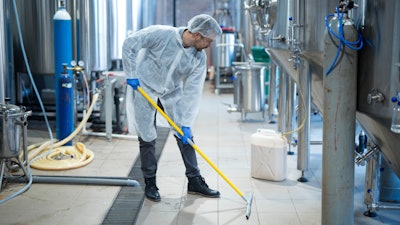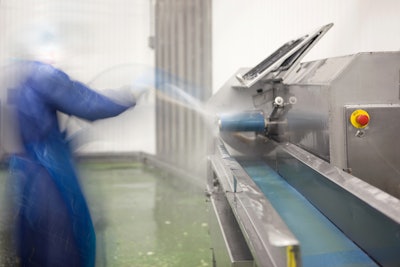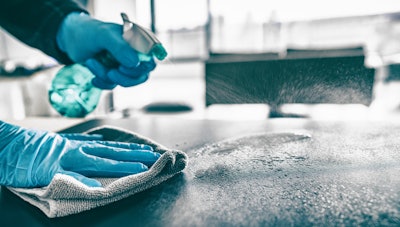
Traces of COVID-19 were recently discovered on imported food packaging, sending consumers into a panic. During this time of heightened public health concern, the last thing food manufacturers need is lost trust from buyers due to food safety concerns.
As a food manufacturer, food safety is always a top priority, but it has become even more important during the pandemic. While there’s no current connection between pests and the spread of COVID-19, these filthy critters can still threaten food safety by spreading other harmful pathogens and bacteria around your facility.
An integrated pest management (IPM) program that focuses on sanitation and disinfection can help discourage pests from entering your facility and spreading germs that can contaminate your products and sicken your employees.
Pests need food, water and shelter to thrive and food processing facilities happen to have an abundance of food scraps, hiding spots and machinery covered in condensation. This makes facilities as such a prime target for all kinds of pests from cockroaches and rodents to flies and stored product pests.
Certain pests such as cockroaches, flies and rodents can slip into your plant through unsealed cracks, open doors or windows and even shipments. Once inside, rodents specifically, can cause structural damage and spread bacteria and pathogens that can contaminate your products. Without a pest management plan that prioritizes prevention techniques over reactive treatment, your business could face expensive pest infestations, halted operations and a tarnished reputation.
One preventive measure you should already be implementing to maintain high standards of food safety is a rigorous sanitation routine. Not only does maintaining a clean facility help ensure the safety of your employees, but it also helps keep pests out by removing the leftovers and moisture that would attract them. With amplified sensitivity to virus transmission, it’s important to make sure disinfection is also part of your cleaning efforts.
You might think you’ve got virus transmission covered with your cleaning routine but, if you’re not using disinfectants as part of your process, you’re leaving your business exposed to the many diseases and illnesses pests can help spread. To protect your employees, products and the rest of the supply chain, you must practice a combination of cleaning, sanitizing and disinfecting regularly. Let’s look at the various areas of your facility that should be sanitized and disinfected to help prevent pest activity and the chance of pathogens and bacteria being spread.
 iStock
iStock
Machinery
Your processing equipment should be thoroughly sanitized and disinfected with low-toxicity products daily. Not only is this the lifeblood of your operations, it’s also a prime target for small pests to find food scraps and moisture to feed on. The dark and warm spaces under the machinery also make good hiding spots for these critters, so be sure to check those areas regularly.
Counters, door handles and other high-traffic areas
These spaces should be a top priority for disinfecting daily and between shifts, if possible. A powerful disinfectant will remove 100% of bacteria and pathogens on these surfaces when used correctly. When selecting products to keep your facility pathogen-free, read the product label and adhere to the product’s directions to see the most effective results. Pay attention to the toxicity levels of a product. It’s best to use a powerful disinfectant to kill bacteria and pathogens that may be living on surfaces, while having low toxicity levels to other organisms. Orkin, for example uses a powerful disinfectant to kill 100% of bacteria and viruses on hard, non-porous surfaces.
 iStock
iStock
Trashcans and dumpsters
No one likes dealing with garbage more than they have to but a good waste removal process is more important in helping to eliminate pests than you think. Replace trash liners daily and wipe away any build up on the trashcan on a regular basis. For dumpsters, make sure they are thoroughly sanitized and closed tightly. Be sure to adjust your waste removal schedule if your operations have changed due to COVID-19 to avoid trash build up near your facility.
Drains
Cockroaches, flies and even rodents can crawl through drains into your facility. To avoid this, use a cleaning agent that breaks down organic matter to flush your drains on a quarterly basis, and more often if needed, to make sure you keep pests from hunting for food in your drains.
To ensure your disinfection efforts are effective, be sure to remove all dirt from the areas you plan on disinfecting. Any dirt left behind can form a protective layer that prevents the disinfectant from working as it should. When using chemicals like disinfectants near food-handling areas, work with your pest control provider to ensure the product(s) you’re using are safe to be used around food.
Whether you have a dedicated sanitation team or it’s a facility-wide effort, be sure to maintain communication with your pest management provider. While preventive measures can help deter pests, it doesn’t eliminate them, and your provider will know the best way to treat any pest issues that may occur.
Despite the disruptions caused by the COVID-19 pandemic, people still need to eat and will continue to be conscious of providers who are going the extra mile to ensure their products are safe from processing to delivery. By working with your employees and pest management provider to implement a sanitation and  Benjamin Hottel
Benjamin Hottel
Benjamin Hottel is a Technical Services Manager for Rollins. He provides technical support and guidance across all Rollins brands in the areas of training and education, operations and marketing. For more information, email [email protected] or visit www.orkincommerical.com.























